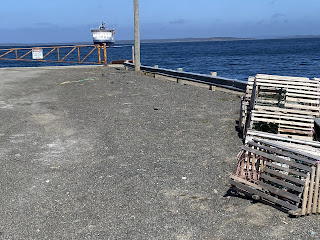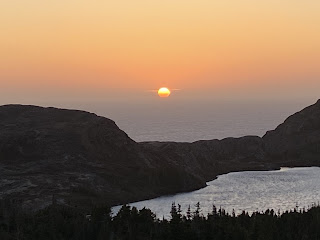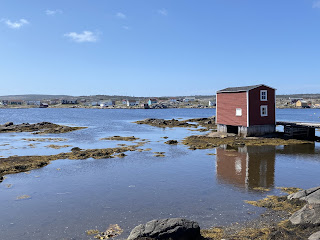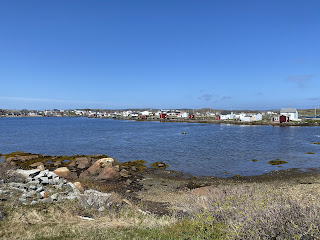Fogo Island is the largest of the off shore islands of Newfoundland and Labrador. The island is just over 200 square kilometres so although you can drive it in a day I decided to spend a couple of days here this time so I could really look around.
First up was the ferry to get there. As with many places in Newfoundland and Labrador I like how the road just ends at the ferry dock - not even a building, just a gate across the end.
While waiting for the ferry I settled in with my toutons. Toutons are a popular traditional dish from Newfoundland - simplicity itself, and perfect simplicity! As uninspired as it may seem, a touton is merely a piece of fried bread dough. Traditionally served with butter and molasses, these days you can also find them served with a syrup or jam (though the use of anything but molasses causes consternation for some foodways purists).
And here comes the ferry.
My turn next.
All loaded and away we go.
Leaving the mainland behind.
One of the stops along the way to Fogo Island … I’m actually coming back here in a few days.
Although the sunshine was lovely (and as you know, I haven’t seen much of it this trip), it was still really cold outside on the deck! No problems finding a seat though!
And here we are arriving on Fogo Island.
The community of Fogo - population approximately 700.
St. Andrew’s Anglican Church (built in 1915) and Cemetery, both recognized as municipal heritage sites.
The Fogo Court House, built in 1908.
This is where I stayed in Fogo - Peg’s Place. Great place run by lovely people…and they make delicious toutons!
The community of Tilting - population approximately 200. Tilting is really interesting - the whole community has been designated as a National Historic Site of Canada. Much of Tilting’s landscape is still used in the same way that the original Irish settlers used it in 1730, as well it has retained an unusually complete range of vernacular building types. Still inhabited by descendants of its early families, Tilting survives as a rare example of a once common Irish-Newfoundland cultural landscape.
Sandy Cove - one of the rare sandy beaches in Newfoundland.
The community of Joe Batt’s Arm, spanning both sides of the harbour. Like Fogo, its population is also approximately 700, and they are the two biggest communities on Fogo Island.
Off in the distance you can see the Fogo Island Inn. More on it in my next post when I was able to get a little closer so you can see it better.
There are some lovely hiking trails on Fogo Island and I did a couple while I was here. This one is called Joe Batt’s Point Trail, but locally it’s known as the ‘Auk Walk’… you’ll know why soon.
You’ll see more of that little black structure in my next blog post…it’s one of four amazing artists’ studios on Fogo Island.
Coopers Gaze. A ‘gaze’ is a hunter’s blind and is usually erected at a point where birds or wildlife pass. Made from nearby materials - rocks, turf, trees, or bushes - the wall of the gaze is made high enough to hide the hunter from their prey. This gaze was made by early hunters and has been used for generations.
At the end of the trail stands a memorial to a giant seabird that was hunted to extinction - the great auk. For thousands of years the great auk lived along the North Atlantic coasts, congregating on remote islands where there were plentiful fish to hunt. Sadly these large seabirds were also hunted, by humans, until the entire population was wiped out. The last great auk was sighted in 1852. The Great Auk Sculpture faces another similar sculpture in Iceland. That sculpture in turn points towards the Icelandic island of Eldey, the site of the last known great auk breeding colony.
Yes I really was there. And he’s a mighty fine Auk!
This was an amazing place just to sit and watch the waves!!
My hat, and I, rested here on our way back.

























































No comments:
Post a Comment